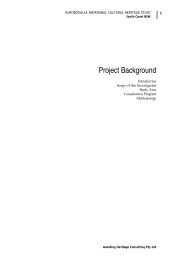Eurobodalla Integrated Water Cycle Management Strategy
Eurobodalla Integrated Water Cycle Management Strategy
Eurobodalla Integrated Water Cycle Management Strategy
Create successful ePaper yourself
Turn your PDF publications into a flip-book with our unique Google optimized e-Paper software.
<strong>Eurobodalla</strong> <strong>Integrated</strong> <strong>Water</strong> <strong>Cycle</strong> <strong>Management</strong> <strong>Strategy</strong><br />
Uncontrolled access to water courses for farm animals<br />
Septic tank discharges in wet weather<br />
<strong>Water</strong> quality issues within the closed lagoons. These can be due to natural<br />
decomposition of seaweed or urban nutrient impacts from runoff.<br />
6.2.2 <strong>Water</strong> Quality Issues<br />
<strong>Water</strong> quality provides an important indicator of overall catchment health. One of the main<br />
environmental objectives of catchment management is to monitor and manage the activities<br />
that impact upon the catchment. The Clyde, Tuross and Moruya Rivers have failed to meet<br />
five of the EPA’s <strong>Water</strong> Quality and River Flow Interim Environment Objectives (<strong>Integrated</strong><br />
water catchment quality plan) criteria. These failed criteria are listed below.<br />
Faecal coliforms<br />
pH<br />
Turbidity<br />
Nutrients<br />
Dissolved oxygen (DO).<br />
6.3 Urban Planning Issues<br />
6.3.1 Population Distribution<br />
The <strong>Eurobodalla</strong> Shire covers a large area and varied landscapes, and is bordered by the<br />
Tasman Sea in the east, the coastal mountains to the west, Wallaga Lake in the south and<br />
Lake Durras to the north. More than 85% of the Shire population live along the coast, with<br />
50% of the coastal population located in the Batemans Bay/Tomakin area. Narooma and<br />
Moruya are the other two main business centres, which account for about 20% of the<br />
coastal population. The remaining coastal population (15%) is scattered among the<br />
numerous small villages along the coast.<br />
The remaining 15% of the shire population who live away from the coast are predominantly<br />
located along the major river flats, as their livelihood is based on agriculture. The main<br />
agricultural produce from the <strong>Eurobodalla</strong> Shire consists of dairying, cattle beef and fodder.<br />
Other significant industries include tourism, oyster farming and forestry.<br />
Demographic Profile<br />
Analysis of the recent census population data shows that around 30% of the population in<br />
the <strong>Eurobodalla</strong> Shire are aged 60 or older (see Figure 6-1 below). The 20 to 25 and 26 to<br />
29 age group represents the lowest proportion of the population under the age of 80. The<br />
emigration of young adults from the shire and immigration of retirees to the Shire is a<br />
familiar trend across NSW coastal communities.<br />
37

















